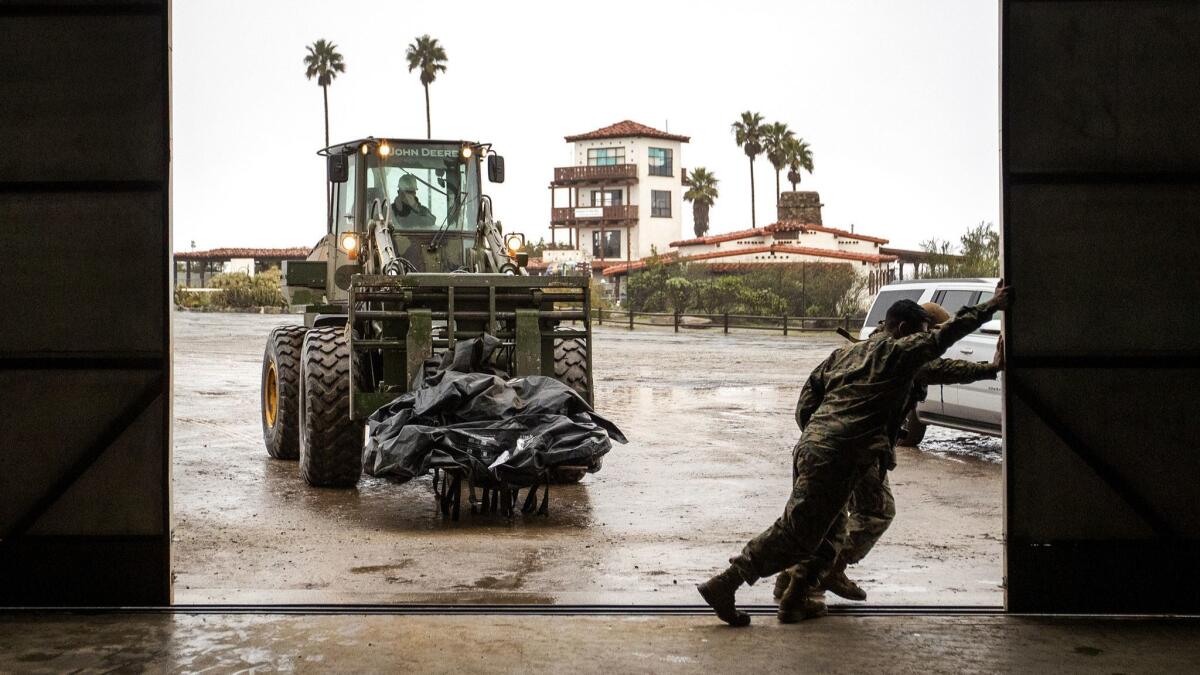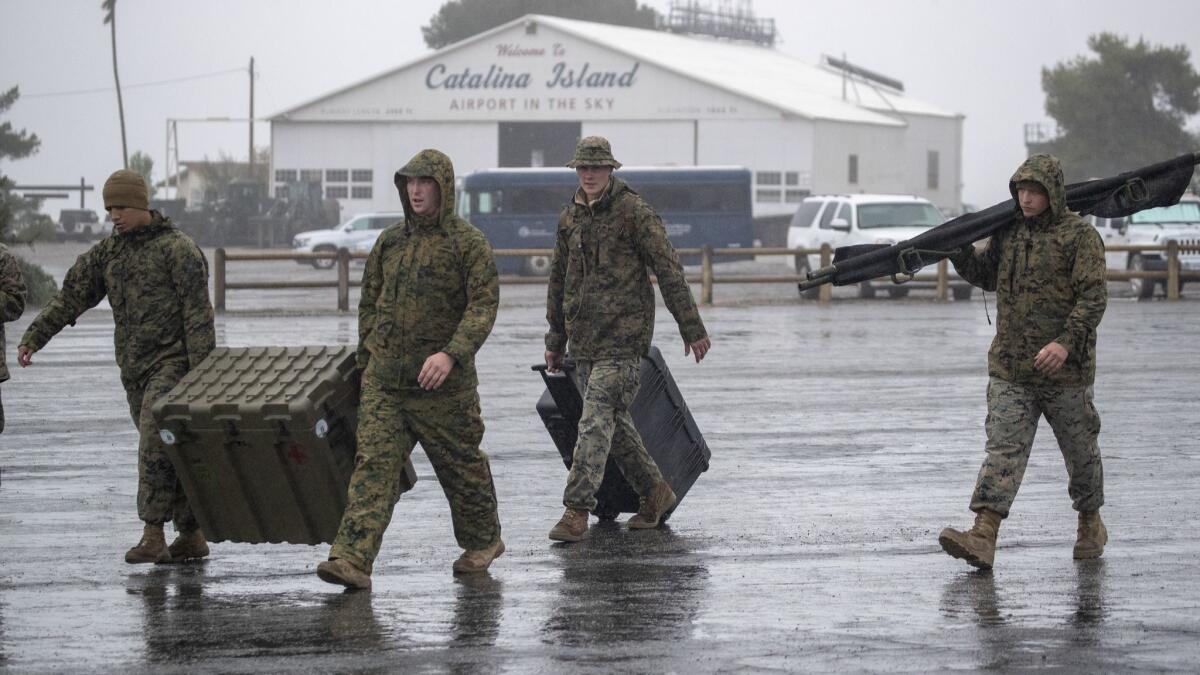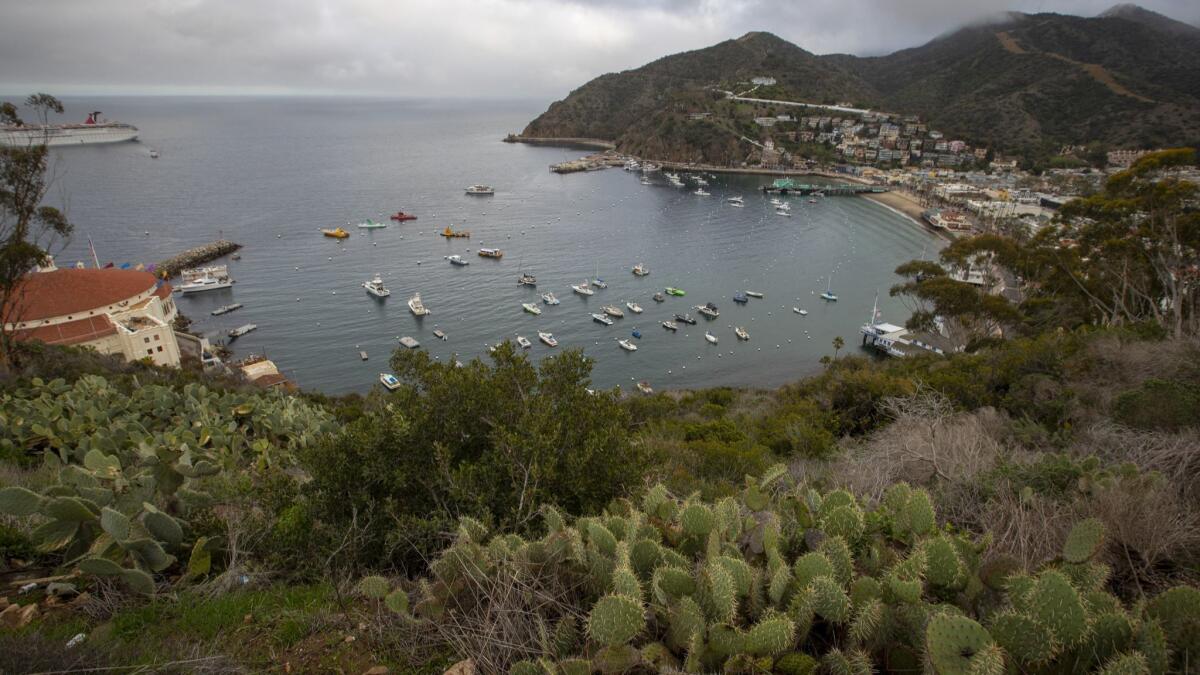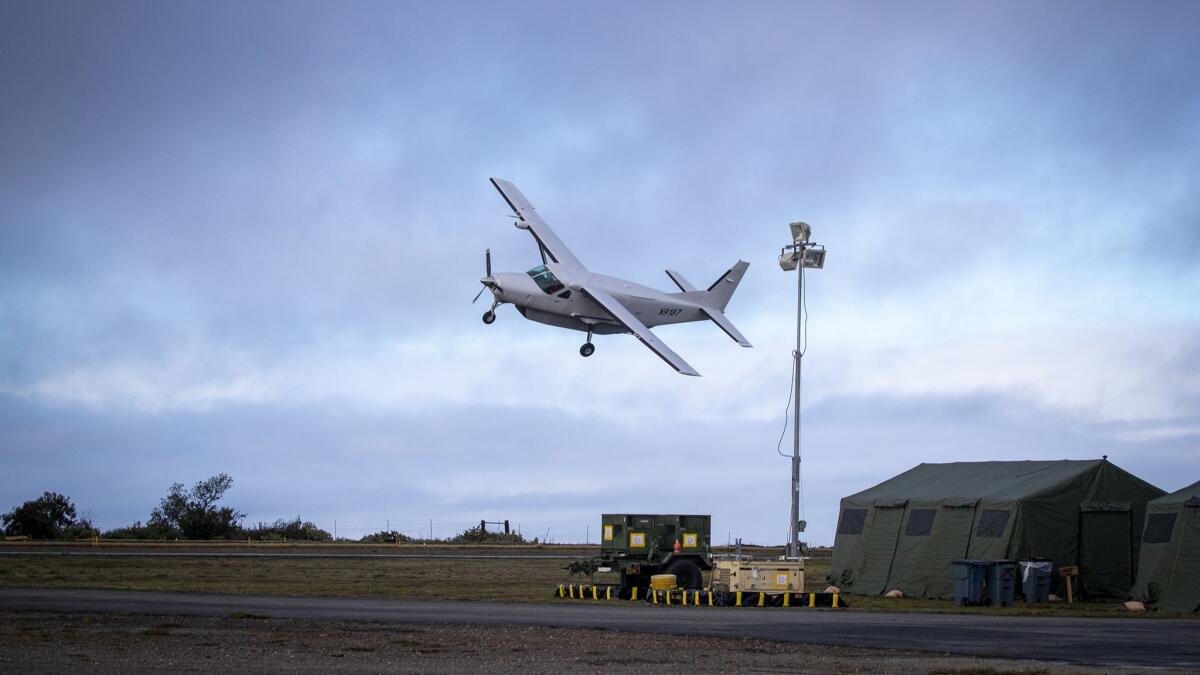Marines ‘invade’ Catalina Island to fix crumbling airstrip at Airport in the Sky

Reporting from Santa Catalina Island — The sky was a gloomy gunmetal gray Monday as dozens of U.S. Marines swarmed the notoriously tricky airstrip high atop Santa Catalina Island.
By days end, the Airport in the Sky resembled a war zone full of heavy machinery, trucks, troops in camouflage and green military tents.
The squadron was on a mission to fix a problem that can make takeoffs and landings a daunting prospect for even the most experienced pilots: potholes, rocks and loose chunks of asphalt on the 75-year-old runway.
Under an agreement with the nonprofit Catalina Island Conservancy, which owns and operates the facility about half an hour’s drive from Avalon, the Marines and some Navy Seabees will repave the 3,000-foot-long runway with concrete.
The $5-million project, which will be funded by donations to the conservancy, is intended to keep the runway open for decades to come. It will also provide the Marines with valuable training in a challenging island setting roughly 22 miles from the mainland.
Marc C. Lee, a flight instructor and author of “Flying to Catalina Island: A Pilot’s Information Guide,” described the effort as “a huge improvement for people who like to fly, and for the local economy, which relies on air transportation for a lot of the island’s supplies.”
“Many pilots don’t fly there simply because of the condition of the runway, which has only gotten worse over the past decade,” he said. “It’s like driving over an old-fashioned washboard.”
Tony Budrovich, president and chief executive officer of the conservancy, was more blunt: “The runway’s condition had put the airport at risk of closure to the public.”
Over the years, the conservancy has patched the runway with an asphalt slurry at an annual cost of about $250,000, he said. But the California Department of Transportation’s Aeronautics Division warned the conservancy recently that it needed a long-term repair plan in place by 2018 if it was to continue using the facility as a public airport.

The airstrip is the island’s delivery hub for U.S. mail, United Parcel Service and other carriers. An estimated 3.5 million pounds of freight, including medical and emergency supplies, is shipped through the airport annually.
“We asked engineers to design a runway that would give us another 75 to 100 years of service,” Budrovich said.
The partnership with 1 Marine Expeditionary Force based at Camp Pendleton and the 3rd Marine Aircraft Wing from Marine Corps Air Station at Miramar, Calif., is part of the Department of Defense’s Innovative Readiness Training Program, which pairs community needs with military training opportunities.
In a previous operation, for example, the Alaska Army National Guard’s aviation battalions transported medical personal and equipment to remote villages at Kodiak Island.
But a controversial deployment in 2017 triggered a brief showdown between Orange County sheriff’s deputies, residents and environmentalists over plans to have Marines blow up vintage stone-and-mortar dams along Santiago Creek in the Santa Ana Mountains.
Officials said the demolition conducted by the U.S. Forest Service and the Marine Corps was needed to restore natural creek flows, enhance wildlife habitat and eliminate safety hazards along the creek. Opponents worried it would kill aquatic wildlife and wipe out popular swimming holes beneath two of the dams.
The Catalina airport project is part of an ongoing effort to restore the island’s luster as a tourist destination.
But repaving the runway will solve only one of several issues that give it a reputation for being tricky — although not necessarily dangerous.

The first 2,000 feet of the runway is an uphill grade, but then it runs slightly downhill. This “crown” creates an optical illusion in which the runway looks shorter than it is to approaching aircraft. Also, at each end of the runway — and along its north side — the terrain drops off precipitously, with slopes approaching 45 degrees. Along the south side are the terminal buildings and an apron for parked aircraft.
In 1984 a private Learjet 24 overshot the runway and crashed over a 90-foot bluff, killing all six people aboard. A federal investigation concluded that the aircraft should never have attempted the landing because the runway was too short.
Jets were subsequently banned from the airport.
Then there are the weather problems at the airport including fog, which on Monday postponed the arrival of 75 additional Marines.
Built in 1941 by the Wrigley family, of chewing gum fame, Airport in the Sky was created by leveling two mountaintops and filling the canyon between them. It was named for its location at one of the island’s highest points – an elevation of 1,602 feet.
Setting down on the runway, some pilots say, is like landing on an aircraft carrier at sea.
During World War II, the Office of Strategic Services, a forerunner of today’s CIA, used the island as a secret training base for intelligence agents, and the runway was covered with debris so enemy aircraft couldn’t use it to attack Southern California’s mainland.
The airport was opened to the public in 1946. The conservancy took it over in 1972 and manages it as a general aviation airport.
The airport, which serves the island’s businesses, roughly 5,000 residents and 1 million annual visitors, was closed Dec. 10 so contractors could move in and pulverize the runway’s asphalt into gravel that will serve as a base for the new concrete surface.
On Monday, commercial aircraft continued to land on an adjacent temporary runway, provided they had obtained advanced permission.
The airport restaurant, the DC Grill, which is popular among hikers and backpackers, remains open.
“If someone asks what we’re doing here,” 2nd Lt. Zachary Bodner, a spokesman for the Marines, said with a smile, “I’ll just tell them, ‘We’re rebuilding this airport. You’re going to like it when we’re done.’”

Twitter: @LouisSahagun
More to Read
Sign up for Essential California
The most important California stories and recommendations in your inbox every morning.
You may occasionally receive promotional content from the Los Angeles Times.











